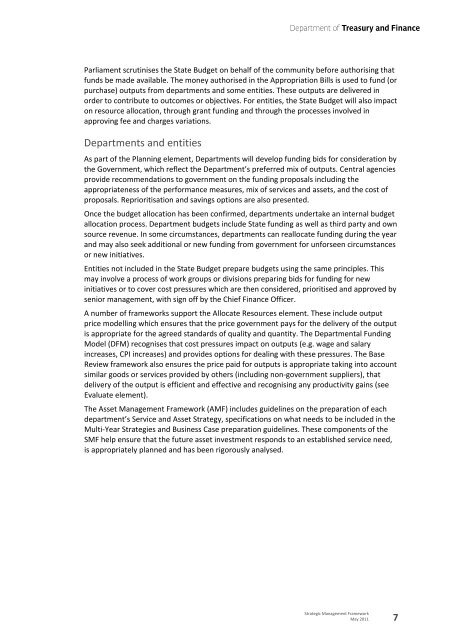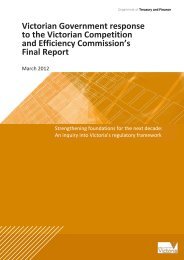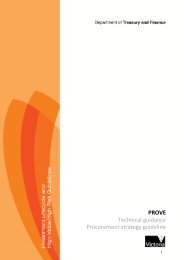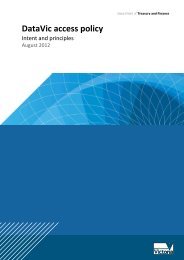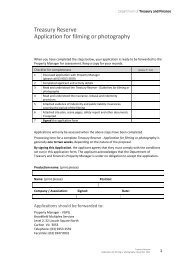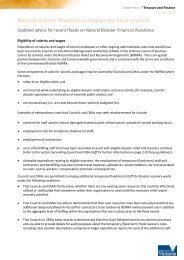Strategic Management Framework guide - Department of Treasury ...
Strategic Management Framework guide - Department of Treasury ...
Strategic Management Framework guide - Department of Treasury ...
You also want an ePaper? Increase the reach of your titles
YUMPU automatically turns print PDFs into web optimized ePapers that Google loves.
Parliament scrutinises the State Budget on behalf <strong>of</strong> the community before authorising thatfunds be made available. The money authorised in the Appropriation Bills is used to fund (orpurchase) outputs from departments and some entities. These outputs are delivered inorder to contribute to outcomes or objectives. For entities, the State Budget will also impacton resource allocation, through grant funding and through the processes involved inapproving fee and charges variations.<strong>Department</strong>s and entitiesAs part <strong>of</strong> the Planning element, <strong>Department</strong>s will develop funding bids for consideration bythe Government, which reflect the <strong>Department</strong>’s preferred mix <strong>of</strong> outputs. Central agenciesprovide recommendations to government on the funding proposals including theappropriateness <strong>of</strong> the performance measures, mix <strong>of</strong> services and assets, and the cost <strong>of</strong>proposals. Reprioritisation and savings options are also presented.Once the budget allocation has been confirmed, departments undertake an internal budgetallocation process. <strong>Department</strong> budgets include State funding as well as third party and ownsource revenue. In some circumstances, departments can reallocate funding during the yearand may also seek additional or new funding from government for unforseen circumstancesor new initiatives.Entities not included in the State Budget prepare budgets using the same principles. Thismay involve a process <strong>of</strong> work groups or divisions preparing bids for funding for newinitiatives or to cover cost pressures which are then considered, prioritised and approved bysenior management, with sign <strong>of</strong>f by the Chief Finance Officer.A number <strong>of</strong> frameworks support the Allocate Resources element. These include outputprice modelling which ensures that the price government pays for the delivery <strong>of</strong> the outputis appropriate for the agreed standards <strong>of</strong> quality and quantity. The <strong>Department</strong>al FundingModel (DFM) recognises that cost pressures impact on outputs (e.g. wage and salaryincreases, CPI increases) and provides options for dealing with these pressures. The BaseReview framework also ensures the price paid for outputs is appropriate taking into accountsimilar goods or services provided by others (including non‐government suppliers), thatdelivery <strong>of</strong> the output is efficient and effective and recognising any productivity gains (seeEvaluate element).The Asset <strong>Management</strong> <strong>Framework</strong> (AMF) includes <strong>guide</strong>lines on the preparation <strong>of</strong> eachdepartment’s Service and Asset Strategy, specifications on what needs to be included in theMulti‐Year Strategies and Business Case preparation <strong>guide</strong>lines. These components <strong>of</strong> theSMF help ensure that the future asset investment responds to an established service need,is appropriately planned and has been rigorously analysed.<strong>Strategic</strong> <strong>Management</strong> <strong>Framework</strong>May 2011 7


